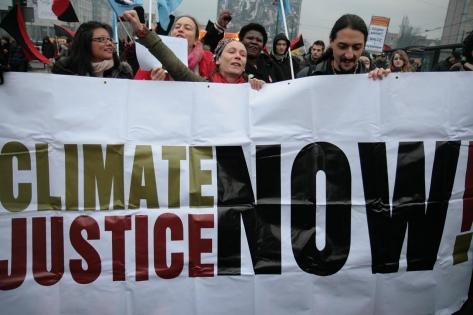While the costs of mitigating and adapting to climate change rise and thus the need for climate finance in developing countries grows, wealthy governments shift focus from public support to private finance. But can the private sector meet the needs of those most impacted by climate change?

In the halls of the UN climate negotiations in Doha, Qatar, you will hear a mantra that’s being echoed by developed country governments from their capital cities to international forums. It goes something like this: We’re broke. There’s no public money. And so, we have to use the scarce resources we do have to leverage massive wealth in the private — and particularly the financial — sector.
You’ll also find in the halls of the annual climate summits the faces of private interests — industry reps, investors, and carbon traders. They’re a regular fixture here, but this year the private sector has taken centre stage in debates over climate finance.
At COP18 there are seven times as many side events about getting private finance and carbon markets engaged in climate action as events highlighting the role of public funds.
There has also been a strategic shift in the rhetoric of developed countries away from talking about “providing” climate finance to speaking about “mobilising” money. The former implies public flows. The latter suggests countries are shifting emphasis toward looking outside national budgets for financial resources.
Nowhere is the trend toward privileging the private sector more apparent than in the Green Climate Fund (GCF) — the newest financial institution under the climate Convention. After many contentious debates during the Fund’s design phase, industrialised nations succeeded in creating a sub-fund that guarantees the private sector direct access to the fund.
Countries did win one concession — a ‘no-objection procedure’ that is meant to keep multinational corporations and international investment banks from going directly to the Green Climate Fund to undertake work in countries without the knowledge of national capitals. But investors are already starting to push back, saying that any kind of vetting process by the UN would make private sector engagement untenable.
In light of these challenges, the GCF’s board will have to grapple as they write the Fund’s business model this year with the question of what the ultimate purpose of the Green Climate Fund is — to maximise the involvement of the private sector, or to support low-carbon, climate-resilient sustainable development in poorer nations as its mandate states?
While these two aims don’t have to be mutually exclusive, lessons from existing private sector institutions – like the World Bank’s International Finance Corporation – show that private finance often bypasses low-income countries, fails to reach the poor in middle-income countries, and prioritises large corporations over small and medium enterprises.
In addition, the use of financial intermediaries to repackage and channel capital leads to serious challenges in transparency and public accountability. Particularly important is the fact that private sector money flows where the profit potential is greatest. For a climate fund this means big, mainly mitigation activities — not community-scale projects, adaptation, or disaster relief.
Certainly, the private sector plays a critical role in any economy – and without its participation in making the shift away from dirty energy and polluting industry there will be no transition to a low-carbon future. But the private sector efforts that the Green Climate Fund should support are domestic enterprises that will reinvest wealth to meet the climate priorities of the people and communities most impacted by global warming.
